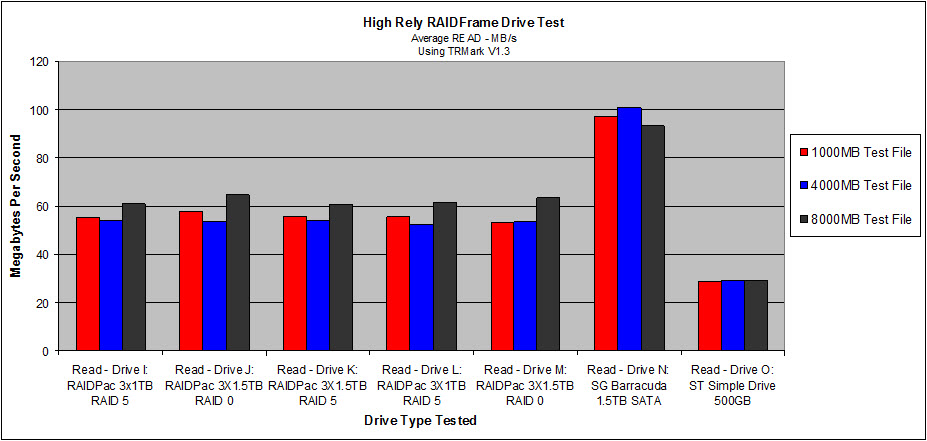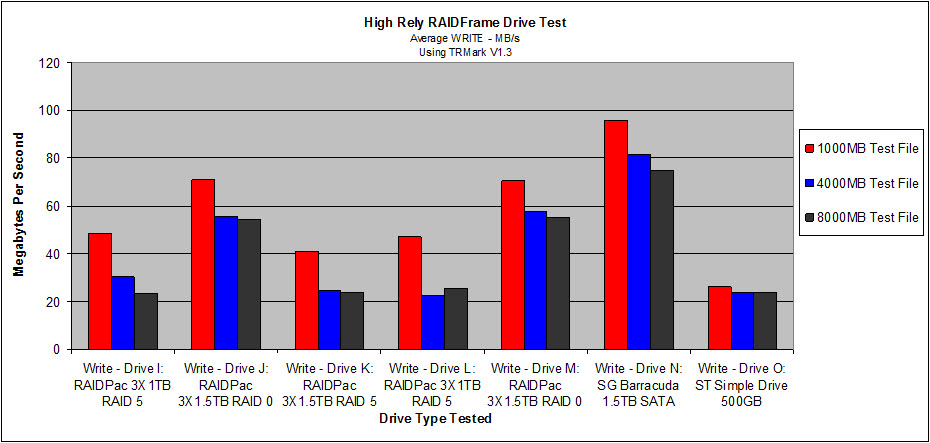Hi-Rely RAIDFrame: External Disk-To-Disk Backup Via eSATA
Testing And TRMark
As configured, we set up the RAIDFrame on a test PC with the following specs:
- Intel Pentium D, 2.80 GHz
- 1GB RAM
- Windows Server 2003 Enterprise SP2
- Western Digital WD6400AACS (640GB SATA) (C:)
- RAIDPac Drive 3 x 1TB, RAID 5 (I:)
- RAIDPac Drive 3 x 1TB, RAID 0 (J:)
- RAIDPac Drive 3 x 1.5TB, RAID 5 (K:)
- RAIDPac Drive 3 x 1TB, RAID 5 (L:)
- RAIDPac Drive 3 x 1.5TB, RAID 0 (M:)
- Seagate Barracuda 7200.11 1.5TB SATA (N:)
- SimpleTech SimpleDrive 500GB (USB) (O:)
- SimpleTech (re)drive 500GB (USB) (O:)
- High-Rely PCI Express eSATA adapter card
For the SATA comparison, we added a new 1.5TB Seagate hard drive mounted as a secondary internal disk for the system. For the USB Storage, I used two SimpleTech 500GB models; the SimpleDrive and the (re)drive.
For our first test, I used Highly Reliable’s own in-house performance tool, TRMark. TRMark is a command line test application that produces read and write rates while sending and receiving a file of a designated size to the destination test drive. The output is then displayed in KB, MB, and GB, in seconds, minutes, and hours. For this test, I generated three different sized files: 1,000MB, 4,000MB, and 8,000MB. Using a batch file, I let the test run overnight and used UltraEdit to weed out the unnecessary characters in the 200MB files created by the process. Each drive was tested five times in drive letter order. Also, to get some comparable stats, I included the stand-alone 1.5TB Seagate Barracuda SATA drive and the SimpleTech SimpleDrive external USB.
Here are the results:
The file sizes of the tests’ output showed little to some variation correlating between the RAIDPac’s eSATA drives. The fastest eSATA rates come from the 8,000MB test, where the average read tests showed rates of above 60 MB/s. The second best set of eSATA results came from the 1,000MB file, which ranged between 53-57 MB/s. Keep in mind that we are comparing internal SATA versus external SATA, where the external device is sharing a 3 Gb/s link between all of the attached devices. In this case, as we'd expect, the clear winner is the internal Seagate Barracuda drive, which averaged between 93 MB/s and 100 MB/s. Lastly, we see the difference between USB 2.0 and eSATA, as the latter drives outperform the fastest data rate produced by the external USB drive.
In the write test, we see better performance for the RAIDPacs in the smaller 1,000MB file test. Whereas in the read test we see all the eSATA drives performing at similar numbers, the write test shows that the RAIDPacs configured with RAID 0 significantly outperform their RAID 5 competition. The RAID 0-based RAIDPacs wrote the 1,000MB files at speeds just over 70 MB/s, while the larger file tests on the RAID 5-based RAIDPacs fared just a little better than the SimpleTech USB drive. Still, you see a definite performance delta between the RAID 0- and RAID 5-based RAIDPacs.
Get Tom's Hardware's best news and in-depth reviews, straight to your inbox.
-
yyrkoon Perhaps I missed something, But I am curious as to how they got 3 drives per port on the port multiplier. I am familiar with port multipliers, but not the technology they use here apparently.Reply
Also, on a side note, I think this device would be more useful if it allowed you to run RAID 10, but with two out ports. Perhaps even multilane would be in order in this case ? -
yyrkoon Let me clarify what I said above. I feel the device would be "better" if they allowed it to be configured to run RAID 10 using two RAIDPacks.Reply -
jeffunit Nice hardware, but a bit spendy. My software based raid 5 array has higher performance over gigabit ethernet, uses commodity parts, and is much cheaper. I am sure my array costs well under $1000 with 8 750gb drives. Since I am using supermicro hot swap sata drive cages, all I have to do is press a button and the drive comes out. 4 screws, and the drive is removed. Takes well under 5 minutes to remove a drive and put in a new one, and it just takes a philips screwdriver.Reply
And why are there two 450w power supplies? Even if the box is full, that is 30 watts per drive, which is a crazy amount of power. If they stagger the drive spin up, they would never need more than 225w tops.
-
climber This should be a 6Gb/s SATA 3.0 design with port multipliers. If you wanted to back up serious amounts of data to this thing you'd never finish, it would always be in backup mode.Reply -
so if one of the three drives should fail inside a RAIDpac, you have to eject the whole RAIDpac to replace that drive?Reply
That sets the RAID offline ... a RAID 5 should be allow hotswapping a failed disk.
And two PSU but not redundant ? ... doens't seem very HIGH RELIABLE -
thehighrelyguy Although some of these points were mentioned in the article, not being on the front page, these important features may have been missed by a few readers and may answer some of your questions.Reply
1. Each RAID pack has an integrated RAID 5 / RAID 0 controller. This means the RAIDPACs can operate completely standalone without the addition of any special controllers or driver software. Thus, left with nothing but a RAIDPac, you could connect it via eSATA to your motherboard and restore the data.
2. The RAIDpacs use standard SATA hard drives. At present, 2.0TB drives are available making the available capacities 4TB in RAID 5 and 6TB in RAID 0 per RAID pack.
3. There is also a 1 bay RAIDFrame available which can use RAIDPacs interchangeably with the 5 Bay if necessary. The one bay has both ESATA and USB connections for portability and ease of connection. The one bay is substantially cheaper than the 5 bay.
4. The dual ATX power supplies were chosen over specialty redundant power supplies because they are the most widely available power supply in the world making field service for this unit in the dead of the night, practical. The 1 bay has this same feature. By using two instead of one, if a power supply dies, you're not dead, the unit is still usable although some bays may not function.
-
thehighrelyguy yyrkoonPerhaps I missed something, But I am curious as to how they got 3 drives per port on the port multiplier. The RAIDFrame is not a single RAID system. The RAIDFrame 5 bay is 5 RAID systems. Each hot swappable RAIDPac is a volume. Port multipliers allow up to 5 volumes (drives) to one SATA channel. Hence one SATA channel, 5 RAIDPacs.Reply

